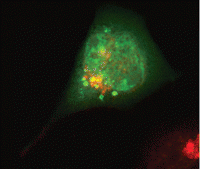Enormous efforts have been expended in the search to discover an effective treatment for Alzheimer's disease that involves inhibiting the production of plaques in the brain- that is, by targeting the enzymes that make amyloid protein. But all of the candidate drugs that once showed promise have proven disappointing in clinical trials.
Therefore another tack for treating the disease may be needed- for example, the removal of plaques from the brain after they have already formed. Indeed, scientists at Rockefeller University have found a molecule that can do just that- at least in cultured rodent neurons.
The senior investigator was Paul Greengard, Ph.D., a professor and head of the Laboratory of Molecular and Cellular Neuroscience at Rockefeller University and a Nobel laureate in medicine. The lead investigator was Yuan Tian, Ph.D., a post-doctoral associate in Greengard's laboratory. Their findings were published online March 2 in the FASEB Journal, a publication of the Federation of American Societies for Experimental Biology.
Cells contain a pathway for degrading long-lived, aggregated proteins in a process called autophagy. So Greengard and his colleagues wondered whether the artificial induction of autophagy might be used to remove from the brain the proteins of which Alzheimer's plaques are made.
They tested various small-molecule enhancers of autophagy on cultured rodent neurons containing clumps of amyloid protein and found that one -SMER28- was successful in removing the clumps.
"At this point it is not clear if SMER28 is appropriate for animal studies [because of issues surrounding] bioavailability and brain permeability, but we would like to test its impact using animal models," Greengard told Psychiatric News. Regarding human clinical trials with SMER28, "it is too early to predict" whether they will be possible, he said.
In any event, Greengard and his colleagues believe that their cell-culture success with SMER28 points to the potential of small-molecule enhancers of autophagy as effective treatments for Alzheimer's.
Gerald Weissmann, M.D., editor-in-chief of the FASEB Journal, pointed out in an accompanying press release, "Autophagy has been called the cell's equivalent of urban renewal. The Rockefeller group shows that strategies to remove the blight in cells that causes Alzheimer's disease are not only worth pursuing, but so far appear to be very promising."
Autophagy enhancers may hold treatment promise for some other neurodegenerative diseases as well, Greengard and his colleagues noted. For example, some small-molecule autophagy enhancers have been found to degrade, in cell culture, aggregates of mutant huntingtin proteins, the hallmark of Huntington's disease. And even more intriguingly, when mice were fed an autophagy enhancer called rapamycin, it extended their lifespan by about 10 percent, David Harrison, Ph.D., a professor at Jackson Laboratory in Bar Harbor, Maine, and colleagues reported in the July 16, 2009, Nature.
"SMER28 stands for 'small-molecule-enhancer-of-rapamycin-28,' but it really has nothing to do with the actual rapamycin molecule," Greengard explained to Psychiatric News. "It is called that because it was initially discovered as an enhancer of the effect of rapamycin to stimulate autophagy. In fact, we now know that SMER28 works through a pathway independent of rapamycin."
The research was funded by the National Institutes of Health and the Fisher Center for Alzheimer's Research Foundation.

